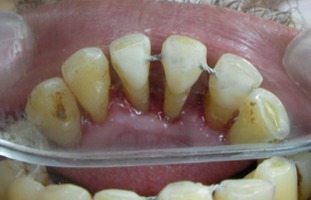
• Dental splinting is a procedure in which periodontially compromised teeth or mobile teeth are joined together with the help of metal or fibre reinforced tooth coloured wire.
• In dental splinting, teeth are joined together using a thin fibre reinforced wire or braided metal wire to increase their stability.
• This will allows them to function normally for food chewing or speaking normally.
• This procedure is beneficial because it allows you to save your teeth for longer time.
There are many types of splints are available:
Depending on the mobility degree of tooth, they are classified as:
Flexible, semi-rigid and rigid.
Ideally recommend the use of semi-rigid splint in cases of dental avulsions of tooth when no bone fracture is present.
The splint can be in the form of either a tooth night guard or an occlusal splint.
Clenching or grinding of the teeth, can happen when a patient is awake or asleep or stressed out.
Chronic teeth clenching and grinding can cause overuse of the muscles controlling the lower jaw, which leads to pain from those muscles.
The load on the joint itself can also cause changes inside the joint which leads to pain in the joint and limited opening of the mouth also known as trismus.
Chronic teeth grinding and clenching can cause temporomandibular disorders (TMD).
TMD are a group of conditions in which muscles controlling the lower jaw, the jaw joint (temporomandibular joint) and supporting structures.
Behavioural management is useful for patients suffering from TMD.
This reduces stress as well as making the patient aware of times during the day when they may be unconsciously clenching or grinding their teeth.
If your teeth are showing wear that indicates you are clenching or grinding your teeth at night or during the day, your dentist may recommend a tooth night guard as a splint.
Night guards prevent the upper and lower teeth from coming into contact while you sleep and makes them effective as preventing teeth wear further.
If you are suffering from a TMD, your doctor might suggest you a night guard or an occlusal splint.
And also other treatments for a TMD include changing to soft diet, reducing stress, improving your sleep, avoid extreme jaw movements such as yawning, applying warm packs to the joint and in patients anti-inflammatory or muscle-relaxant medications can be given.
In some patients, a stabilisation type of occlusal splint is recommended.
It is a slim guard made up of acrylic fitted to the upper jaw and can be either soft or hard.
All the types of dental splint distributes the equal forces generated by clenching or grinding of teeth between the upper and lower teeth, and reduces muscle strain and joint overloading.
Dental splinting using metal or fibre reinforced wire:
• Patients with moderate to severe periodontal disease, tooth mobility can cause to discomfort while eating and decreased in function.
• Treatment of the hyper-mobile tooth can be challenging. Occlusal trauma and mobility in the periodontially compromised teeth leads to worsen the periodontal prognosis.
• Tooth mobility can be controlled and managed with splinting therapy.
• There are much evidence to support the use of tooth stabilization using splinting to improve the periodontal prognosis and mobility.
• Splinting of teeth is a long-term commitment by doctor and patient.
Visit us at bestorthodontistbracespune.in to know more
